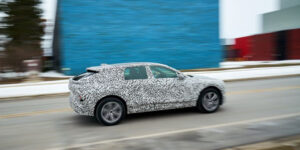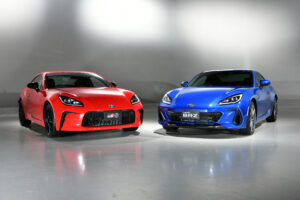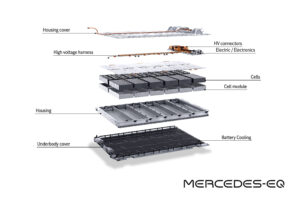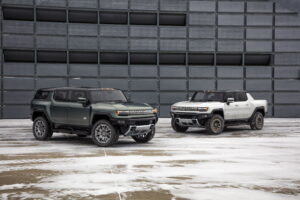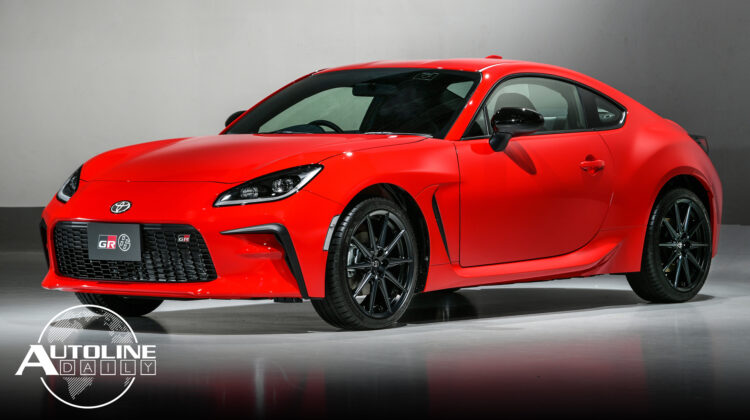

Listen to “AD #3051 – New Toyota 86 and Subaru BRZ Unveiled; BEV Sales Up Strong in U.S.; Hummer EV SUV Revealed” on Spreaker.
Follow us on social media:
Runtime: 10:46
0:08 BEV Sales Up Strong in U.S.
0:47 Tesla U.S. Market Share Down
1:26 Cadillac Testing Lyriq Prototypes
2:00 Battery Dispute Causes Supply Chain Concerns
3:32 New Toyota 86 & Subaru BRZ Unveiled
5:01 Mercedes Shares EQS Battery & Range Details
6:11 Hummer EV SUV Revealed
7:16 Krafcik Steps Down as CEO of Waymo
8:11 Designers Need to Be Under a Tighter Schedule
Visit our sponsors to thank them for their support of Autoline Daily: BorgWarner, Bridgestone, Intrepid Control Systems and ZF.
This is Autoline Daily, the show dedicated to enthusiasts of the global automotive industry.
BEV SALES UP STRONG IN U.S.
Electric cars had an impressive first quarter in the U.S. market. Automakers sold over 77,000 BEVs, up 38% compared to a year ago. They now account for nearly 2% of all new car sales. Almost every EV posted substantial gains, including the Chevrolet Bolt, Nissan Leaf and BMW i3. The Porsche Taycan, Audi eTron, and Hyundai Ioniq and Kona all saw massive gains. And new entries such as the Mustang Mach-E, Polestar 2 and Volvo XC40 Recharge added to the total.
| U.S. EV SALES, Q1 2021 | ||
|---|---|---|
| Sales | Change | % Change |
| 77,000 | +21,200 | +38% |
| Source: Wards Intelligence | ||
TESLA U.S. MARKET SHARE DOWN
As the traditional automakers posted EV gains in the first quarter, Tesla lost market share. Wards Intelligence reports that while sales of the Model Y are soaring, sales of the Model S, X and 3 are dropping. In fact, sales of the Model 3 fell 54% as it was cannibalized by the Model Y. A year ago, Tesla had 78% of the EV market in the U.S. Now, it’s at 61%. That’s still a dominant position. But as more entrants come into the market, Tesla will lose more market share. That’s just a fact. All market share has to add up to 100%. And as more entrants come into the market, everyone ends up with a thinner slice of the pie.
| TESLA U.S. SALES | ||
|---|---|---|
| Sales | Market Share | |
| Q1, 2020 | 43,400 | 78% |
| Q2, 2021 | 47,480 | 61% |
| Source: Wards Intelligence | ||
CADILLAC TESTING LYRIQ PROTOTYPES
Speaking of electrics, Cadillac posted on Linkedin that it’s testing prototypes of the Lyriq, the electric SUV. The post was light on details, but we know the Lyriq will have 300 miles of range, 150 kw fast charging and a starting price below $60,000. It goes into production in the first quarter of 2022 at GM’s plant in Spring Hill, Tennessee. GM will build electric SUVs at that plant for Chevrolet and GMC and even one for Honda.
BATTERY DISPUTE CAUSES SUPPLY CHAIN CONCERNS
The dispute between LG Energy Solutions and SK Innovation has some analysts worried that it could harm the U.S.’s battery supply chain. LG accused SK of stealing trade secrets, and the U.S. International Trade Commission agreed, ruling that SK can make batteries at a plant in Georgia it’s currently constructing, for four years before it essentially has to shut down. Ford and VW plan to use those batteries in its EVs. But SK threatened to pull its operations out of the U.S. if President Biden doesn’t overturn the ITC’s ruling. He has until April 11th to make a decision. Here’s our Autoline insight. We don’t think it matters that much because someone else can come in and buy the plant. So there’s no need to worry about whether or not Biden’s decision will harm battery supplies.
NEW TOYOTA 86 & SUBARU BRZ UNVEILED
Sports car sales are hard to come by these days, but the Toyota 86 and Subaru BRZ twins are living on for another generation. The all-new versions, which are scheduled to launch before the year is out, feature fresh styling with the Subaru having a slightly happier face and the Toyota with front air curtains that flow over the edge of the bumper. In fact, we think those air curtains along with the integrated rear spoiler are styling cues picked up from the Supra. As for the interior, it’s still pretty basic, but features cockpit-like styling and a 7-inch display screen. The cars are practically identical in size to the outgoing models, but thanks to the use of aluminum and lightweighting efforts in the seat and exhaust, they’re lighter than before. They’re also more powerful too. A 2.4L engine replaces the old 2.0L unit and makes roughly 230 horsepower. It’s paired exclusively with rear-wheel drive and either a 6-speed manual or automatic. Acceleration from 0-100 km/h is down by over a full second to 6.3 seconds. These were already fun cars to toss around on the road, but with a 50% improvement on torsional rigidity, along with the other upgrades, we can’t wait to get in and drive them.
MERCEDES SHARES EQS BATTERY & RANGE DETAILS
Mercedes’ flagship electric vehicle, the EQS launches soon in August, so more details are trickling in. It rides on a RWD-based platform, but also has the option for AWD, which places an extra electric motor on the front axle. The more powerful setup combines for a total system output of 385 kW. Two battery sizes are available; 90 kWh or 107.8 kWh, which come with either pouch or hard case cells. The larger pack is said to return 770 kilometers of range on the WLTP test cycle, which is about 478 miles. If the smaller pack is equally as efficient, it should return somewhere in the range of 640 kilometers or about 400 miles. The electrical system is based on a 400-volt architecture, which allows the EQS to add up to 300 kilometers or 186 miles of range in 15 minutes.
HUMMER EV SUV REVEALED
Speaking of EVs, the SUV version of the Hummer EV debuted this weekend. We’ve only got a few things to talk about since it’s pretty much identical to the truck. But one of the biggest differences is the wheelbase. The SUV is nearly 9-inches shorter than the truck. That also greatly reduces its turning radius. Almost a full foot and a half less than the truck. And the SUVs pricing is about the same as the truck.
KRAFCIK STEPS DOWN AS CEO OF WAYMO
When it comes to the world of autonomous cars, it looks like Argo is taking a step forward, while Waymo is taking a step back. Argo is reportedly going to go public this year, either through an IPO or a SPAC. The company is already valued at $7 billion thanks to investments from Ford, Volkswagen and others. Meanwhile, Waymo’s CEO John Krafcik told employees in a company blog, that he decided to step down and let others run the company. Those others are Dmitri Dolgov and Tekedra Mawakana who will be co-CEOs of Waymo. With Krafcik, the company commercialized autonomous ride hailing in Phoenix, and raised over $3 billion from outside investors. Krafcik will continue as an advisor to Waymo.
DESIGNERS NEED TO BE UNDER A TIGHTER SCHEDULE
It takes about three years to develop a new car. One of the reasons it takes that long is that automakers actually schedule it to take that long. On Autoline After Hours, Karl Ludvigsen and Jim Hall talked about the benefits of putting designers under a tight schedule.
Karl Ludvigsen: “The Golf came a little latish, but it came just barely in time. And it was quite a successful car of course, in its way, and we still have Golfs. They managed to keep that franchise alive ever since Giugiaro’s first effort. He says in my book, I had three months to do the Gof, the Scirocco and one other car.”
Jim Hall: “It was the Passat, wasn’t it?
Karl Ludvigsen: “The Passat, exactly. And so they launched this whole group of cars. He said ‘I had three months to do it.’ And this just shows how valuable it can be to not have very much time to do something, because it’s not messed about. They’re clear, sharp cars.”
Jim Hall: “One of the problems in design is, there’s a point at which you’re supposed to lift the pen and walk away. And instead, they keep sketching. It’s being optimized, but it’s being overdone. It’s my contention that it’s now the common way cars are designed and I would suggest it’s because of the design tools that designers are using. It’s digital.”
There’s a lot of great information about design in that show. And this coming Thursday, our guest on Autoline After Hours is Matt Brueggeman, the CEO of Flux Mopeds. Those things are electric and he wants to blow the market for micro mobility wide open. Join John and Gary to find out how he wants to do that.
But that wraps up today’s show. Thanks for watching.
Thanks to our partner for embedding Autoline Daily on its website: WardsAuto.com

John McElroy is an influential thought leader in the automotive industry. He is a journalist, lecturer, commentator and entrepreneur. He created “Autoline Daily,” the first industry webcast of industry news and analysis.




